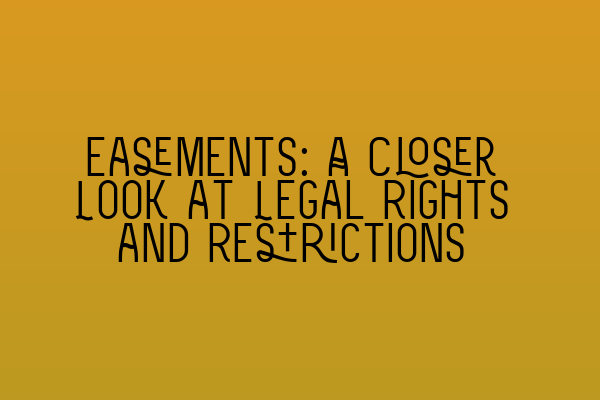Easements: A Closer Look at Legal Rights and Restrictions
Welcome to the SQE Property Law & Land Law blog! In this article, we will delve into the fascinating world of easements, exploring the legal rights and restrictions associated with this important aspect of property law. Whether you are a property owner, tenant, investor, or simply curious about the legal aspects of property rights, this article will provide you with valuable insights. So, let’s get started!
What are Easements and Why are They important?
An easement is a legal right that allows a person to use another person’s land for a specific purpose, such as access, drainage, or the running of utility services. Easements are crucial in facilitating land use and development, as they provide necessary permissions and access rights. They can also add value to a property and impact its marketability. Understanding easements is essential whether you are buying or selling a property or involved in property management.
Now, let’s explore some common types of easements:
1. Right of Way
A right of way is perhaps the most well-known type of easement. It grants someone the right to pass through another person’s land, usually to access their own property or a public road. Right of way easements can be essential for properties that are landlocked or located in areas with limited access.
It is essential to carefully review any right of way easements when buying a property. This will ensure that you understand the rights and limitations associated with accessing your property. Combining legal and conveyancing expertise can help identify any potential issues or restrictions in the easement.
Related Article: Misrepresentation in Contracts: Unveiling Deceptive Practices
2. Utility Easements
Utility easements grant utility companies the right to access the property to install, repair, or maintain utility services. These easements are typically granted for services like water, gas, electricity, and telecommunications. Utility easements ensure that essential services can be readily provided to properties without obstructing the owner’s use of the land.
As a property owner, it is important to be aware of any utility easements on your property. This knowledge can help you understand your responsibilities and limitations when it comes to the maintenance and development of the property.
Related Article: A Closer Look at SQE Contract Law Syllabus
3. Drainage Easements
Drainage easements are designed to manage water runoff and prevent flooding or other water-related issues. They provide the necessary rights for the free flow of water across multiple properties. These easements often involve the installation and maintenance of drainage infrastructure, such as pipes, ditches, or swales.
If your property is located in an area prone to flooding, it is vital to understand the drainage easements that may affect your land. By understanding these easements, you can take appropriate measures to protect your property and ensure compliance with any maintenance requirements.
Related Article: SQE Contract Law: Analyzing Landmark Cases and Influential Judicial Decisions
Restrictions and Limitations on Easements
While easements provide valuable rights, they also come with certain restrictions and limitations. It is important to understand these limitations to avoid any legal disputes or complications. Let’s explore some common restrictions:
1. Excessive Use
Easements are generally granted for specific purposes and uses. Excessive or unreasonable use of an easement may result in legal consequences. It is important to use the easement rights in a manner that is consistent with its intended purpose and does not unduly burden the servient property.
2. Maintenance Responsibilities
Depending on the type of easement, the responsibility for maintenance and repair may lie with the easement holder or the property owner. It is crucial to clearly define these responsibilities in the easement agreement to avoid any misunderstandings or conflicts.
Related Article: Understanding Contractual Capacity: Rights and Limitations
3. Termination
Easements can be terminated under certain circumstances, such as abandonment, merger of properties, or by mutual agreement between the parties involved. Understanding the conditions under which an easement can be terminated is important to ensure your property rights are protected.
Related Article: Interactive SQE Mock Tests for Contract Law: Test Your Knowledge
Conclusion
Easements play a crucial role in property law, providing necessary rights and access for various purposes. Whether you are a property owner, tenant, or investor, understanding easements and their associated rights and restrictions is essential for ensuring the smooth management and development of properties.
If you require expert advice or assistance with easements, we at SQE Property Law & Land Law are here to help. Our team of solicitors specializes in property law and can guide you through the complexities of easements and other property-related matters.
Related Article: SQE Contract Law: Analyzing Landmark Cases and Influential Judicial Decisions
